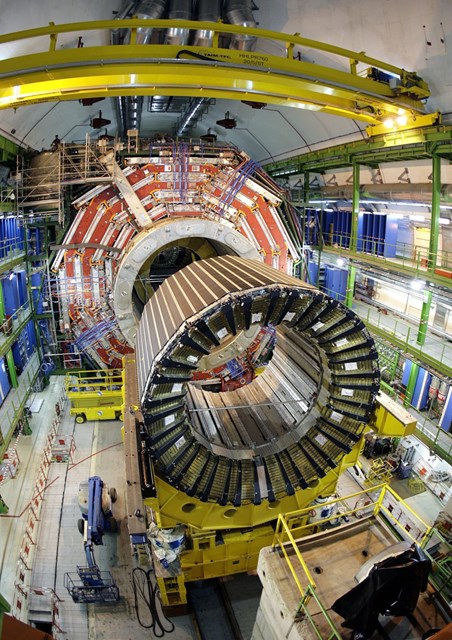
What is your field of study?
I did my doctorate in high-energy physics – particle physics – and my research is on astroparticles.
Could you explain to laypeople what that means?
As we all learned in high school, we are made of molecules, atoms, protons, neutrons and electrons. But we can actually go down to a more precise resolution because the protons and neutrons are composed of smaller particles, called quarks. And there are also a great many more particles that are created at very high energies. With particle accelerators – if they are particle accelerators such as the sun, gamma-ray bursts and supernovas –
Or human-made particle accelerators.
Yes, and we don’t need to go as far as CERN [the world’s largest particle accelerator, on the Swiss-French border]. Old-fashioned televisions, let’s say, were also particle accelerators. The whole vast system of the universe is composed of particles, and on the assumption that we’re curious people who want to know where we came from and where we’re going, the relevant questions are what we’re made of, how matter operates, how the forces operate. Those questions can’t be answered without particle physics.
What’s really interesting in this field is that the more we investigate, the more we discover how much we don’t know. Not long ago, I taught a course on particle physics and was looking for film clips to show the students. I found a segment from the TV series “The X-Files” from the ‘90s in which all kinds of terms relating to particle physics were mentioned – they were a total fiction then, but now we know that they’re real and that they exist.
When you come to work every morning, you’re actually searching for dark matter.
Yes. The search is conducted in two modes. Here in our laboratory at the Weizmann Institute of Science and in the research group of Dr. Ranny Budnik, we’re building prototypes of dark matter detectors. As you can probably guess, it’s far from simple to find dark matter. To improve the odds, we’re actually trying to stretch the boundaries of existing technology and increase the detectors’ sensitivity as much as possible. The second part of the work is joint work with the site in Italy [LNGS – the Gran Sasso laboratory in Italy’s Abruzzo region], where XENON, a large-scale experiment in search of dark matter, has been underway for years.
Everyone has heard of dark matter, but not everyone necessarily knows what it is.

The XENON1T dark-matter detector, at the Gran Sasso laboratory, in Italy. Credit: XENON
Basically, I don’t know what it is either. Dark matter is currently the only explanation for a range of phenomena.
And there’s no direct evidence of its existence. We hypothesize its existence simply because there’s no other satisfactory explanation.
Dark matter isn’t measured directly, but it’s more than a reasonable solution for many problems and issues. Physics, after all, is an experimental science. Observational. We examine and measure all kinds of things, and at the moment we’re examining this theory, of dark matter.
But even from the viewpoint of researchers, it’s only a theory. There’s a problem, and in the absence of a better solution, that’s the solution.
We’re treating it as a model. It’s not something esoteric, of course. There are many experiments and search efforts, and tens, possibly hundreds of millions of dollars are being invested in it. The problem, in any event, is a major one and a real one. We simply don’t know what 85 percent of the universe is made of. Something doesn’t work out in all the equations, all the measurements – and dark matter is currently the leading explanation.
How did you arrive at the 85 percent figure? And when you say measurements, what do you mean?
The speed of the Earth’s rotation depends on our distance from the sun and on the sun’s mass. The speed of the sun’s rotation around the center of the galaxy depends on the mass of the center of the galaxy and on the sun’s distance from the center. Measurements of the speed of the stars’ rotation, as dependent on their distance from the center of the galaxy, are called rotation curves. We expect that the farther we move from the center, the slower a star’s rotation speed will be, but there is endless evidence, from countless galaxies, showing that the speed isn’t reduced. The implication is that a great deal of matter is hidden there that we don’t see with telescopes but whose gravitational influence we discern, hence the name “dark matter.” At the moment, dark matter is also an integral element of the Big Bang theory. We have no way to explain the emergence of the universe’s structures without dark matter, or the tiny distortions we measure in the cosmic-microwave background radiation.
But there are some scientists who maintain it doesn’t exist.
Prof. [Mordehai] ‘Moti’ Milgrom, for example, has a very successful model that rejects the existence of dark matter. According to him, there is no dark matter, but the laws of gravitation need to be changed a little. It’s a successful model, but it explains only some of the issues. The hypothesis of dark matter’s existence remains the leading model.
So how do you look for something whose existence isn’t guaranteed?
In the absence of [actual] discovery to date, all the experimental systems work on upper limits. What does that mean? That an upper limit can be calculated above which “we would have had to see” that phenomenon. We didn’t see it? Apparently the rate must be lower than a certain value, otherwise we would have had to discern it.
A more detailed explanation is required here.
Let’s say I have a model that predicts that on average, every 10th grain of rice is made of gold. That’s easy to check. We open a bag of rice, and if we don’t find gold, we reject the model. But we can also look at it differently. We can say, on the basis of the fact that we didn’t find a grain of gold in the bag of rice we checked, that the likelihood of a grain of rice being made of gold is lower than a certain value.
So, to simplify crudely, it’s a type of elimination.
Actually, what we’re saying is that if the attributes of dark matter were such and such, we would already have had to see something, but since we didn’t see it, they are apparently different. What is clear is that we need to improve the detectors’ sensitivity. At the moment, even though the experimental systems are becoming more sensitive and larger, we still haven’t succeeded in seeing anything. This is what we’re doing here in the lab: trying to develop more sophisticated systems to identify dark matter by improving the capabilities of our detectors.
The working assumption is that dark matter is made of particles with a relatively large mass, but that they create weak interactions, if any, with other materials.
Yes. It’s known as the WIMP model – for weakly interacting massive particle. This model encompasses hypotheses concerning certain behaviors of a particle of dark matter, its mass and its mode of interaction with regular matter. The model enables me to calculate the likelihood and the way a particle of dark matter will interact with regular matter. This happens rarely, but it should be possible.
And that’s actually what’s happening in the pipes or the barrels deep in the earth in Italy.
Our detector is a barrel, about a meter high and a meter in diameter, that’s filled with xenon, a noble gas, in a liquid state, at a temperature of approximately minus 110 degrees Celsius. The barrel is actually a kind of huge thermos. If a dark matter particle is scattered off an atom of xenon within the detector, a complex light signal is created that’s measured by two systems of super-sensitive light detectors situated at both the bottom and top of the barrel. That’s what we’ll see: a flash of light.
But how do you know that the interaction you’re seeing took place with a particle of dark matter? It could be other particles.

The magnet core of the world's largest superconducting solenoid magnet at the CERN's Large Hadron Collider (LHC) in Geneva, Switzerland, March 22, 2007. Credit: AP
The problem is that other particles that reach the detector can also leave this stamp of light within it. This is an advantage because it lets us calibrate and test the detector, and it’s also a drawback because this light stamp can actually resemble a signal of dark matter.
Which is also why this laboratory is buried deep in the ground under a mountain.
Because we’re looking at what are known as “rare events,” there needs to be as little background noise as possible. We’re getting it regularly from above: cosmic rays that strike the atmosphere and create showers of particles. We don’t like that. To minimize the possibility of background noise, we need thick layers of rock. Of earth. That’s why the detector is installed and located under a mountain, within protective layers of water and other materials that block the natural radiation. The materials the detector is made of are also chosen meticulously to ensure a minimum of background noise.
What does the “result” look like?
In searching for the WIMP, I measure, or try to quantify, the chance of such a particle colliding and interacting with regular matter. That’s called a cross section. The higher the cross section, the greater the likelihood of interaction. This is where the detector’s sensitivity comes in: The more sensitive it is, the greater its ability to identify dark matter with a lower cross section. Detectors are becoming ever more sensitive from year to year, and because we haven’t yet seen evidence of dark matter in a detector, we rule out increasingly smaller cross sections. This is actually the name of the game – increasing the detector’s sensitivity and decreasing the magnitude of the cross section to which we are sensitive. We haven’t yet detected WIMP, but we have been able to delineate an upper boundary. We’ve been able to determine that if WIMP did exist in this cross section and in this mass, we would already have been able to see it, because the detector is sufficiently sensitive. As we haven’t seen anything, the interaction must be weaker.
Or there’s no such thing as WIMP.
Yes. That’s also a legitimate explanation, but until we check, we won’t know.
It’s disturbing to think that a certain type of matter exists that’s so vast and widespread but we have no idea what it is or how it behaves.
I see it differently. Think how amazing it is that we even know that there is such a thing, because a few decades ago we didn’t know even that. That’s the thing – we don’t even know what we don’t know. I think that maybe what you’re trying to ask me is whether I believe that there is such a thing as dark matter. Of course, it’s not a matter of belief – maybe that’s not the right word.
I think the question is the degree to which you’re emotionally attached to the idea of dark matter. Does the working assumption that dark matter exists or doesn’t exist affect the concept underlying the search for it?
My approach isn’t to deal at all with the question of whether the matter exists or not. I look at the problem: The numbers don’t add up, and I want a solution. I want to understand what is going on. What happened to the missing 85 percent?
And let’s say that someone says: Fine, I understood what happened. I removed a root from all the equations, I made a few small changes in the laws, and there you go: It all adds up.
Excellent. We’re here to check, right? You have a different theory, one that addresses all the difficulties and that can be checked? We have something to talk about.
Sure. Give me a day or two to get back to you with that. What will happen in that much-anticipated moment, if it actually arrives, when you actually see the flash of light you’re waiting for and it morphs from model into fact?
It will become something real. The truly difficult work will begin only after we see some sort of evidence of its existence. It won’t be easy. First we have to convince ourselves and the world – and convincing ourselves will be harder, by the way – that this is what we saw. When we plan the information analysis, we do it without looking at the data in order to avoid bias. So let’s say, as an illustration, that we expected to see six events and we saw 20. Now we need to be sure that this disparity, this surplus, is evidence of the existence of dark matter, and not some sort of byproduct, because we’ve already had all kinds of strange measurements.
Yes. That’s actually a type of variation on the initial thinking about dark matter. The numbers don’t add up, so we will infer that matter of some sort exists.
Right. The moment I have persuaded others, and have been persuaded myself, that this surfeit of data doesn’t point to background events of any sort, or to problems of measurement, we understand that this is a new type of matter. And then we need to investigate it, too. Maybe it’s not dark matter at all, or it’s something else that’s new? Then we have to start to probe and understand what this new something is.
This experiment – the search for dark matter – has gone on for almost 15 years.
We have now finished running the XENON1T detector at LNGS , and as we speak, we are building the XENONnT, which will start to collect data in a few months, if all goes as it should. We started with a detector of 10 kilos of xenon, then 100 kilos and now 10 tons, which we call the XENONnT. The technology is similar but the scale is larger. The detectors are more sensitive. The materials are cleaner. The methods are more effective and more sophisticated.
So your search capabilities have improved fantastically, but you haven’t made progress in terms of solving the mystery.

Dr. Hagar Landsman-Peles. Meged Gozani
There’s a great deal of beauty and joy in the search itself. It’s a kind of escape room. The happiness, or the satisfaction, lies in the small steps. I’m not looking only at the finish line. The goal I defined for myself isn’t to find dark matter but to examine whether it exists or not, which seems to me psychologically healthier. I build a detector, and I see that it works, and I do a calibration, I characterize it, and I see that with this detector I’ve enhanced the sensitivity tenfold. And I’ve made it work in a certain way. These systems are so complex.
So the strategy isn’t even to think about the finish line?
Yes. These are steps along the way, necessary steps. The challenges are infinite. To build a more sensitive detector. To learn about the attributes of the matter – now we’re running tests related to the physics of materials and of crystals, which encompass a multitude of fields. You can’t say that there has been no progress. We’ve reached a point where I can now say that if dark matter does exist, it can’t be above this line in the graph, because otherwise we would have already seen it. That’s progress. Look, it’s a competitive field.
Everyone wants to enter the history books as the discoverer of dark matter.
Of course. So our battle is to achieve the lowest line on the graph.
In other words, one that will point to the range in which you think it will be possible to find dark matter.
Yes. That’s the goal at the moment, and that’s a lot.
It’s also a more concrete goal.
And that’s also the reward. When a detector works the way it’s supposed to, the joy and the satisfaction are immense. That’s another aspect of this field that’s beautiful. There are so many efforts, there is so much technology. To discover something, it’s not enough for someone to find it. You need the confirmation. The examination. That’s why it’s important for us to be exploring as many different technologies as possible.
There are a number of strategies in the search for dark matter, right? What you’re doing is actually just one way.
We’re doing a direct search. There’s an indirect search – such as astrophysical measurements with particle accelerators – and a direct search.
Do you think you’ll see proof of the existence of dark matter in your lifetime?
I think that in my lifetime, the WIMP model will succeed or fail.
The question will still be there, and a different answer might simply be proposed.
The problem will certainly remain. WIMP is an explanation that could be revealed as the real thing, but it could also collapse. At the moment I have no other option. We’re measuring and examining things. Paper absorbs everything, and there are so many riddles that have yet to be solved.
It’s an endless playing field. The idea that an explanation could be a type of unknown is fascinating in itself.
Absolutely. And what’s marvelous is that the systems themselves are so cool. It’s not some dusty lab with an elderly professor and all kinds of weird machines. It’s an adventure on a huge scale, with hundreds of people who are cooperating and working together. It’s very creative.
It’s also a platform for multiple speculations. When I was preparing for this interview, I found all kinds of hypotheses of scientists and researchers about dark matter, including one related to skin cancer.
Listen, dark matter, whether it exists or not, is part of our world. It could be the cause of all kinds of things. We don’t know. In principle, dark matter could be the reason I’m a redhead. It could be. But even if that’s true, there’s nothing I can do about it.
Other than investigate.
Yes. It’s apparently here, and if we don’t investigate it, we won’t know.
Do you think this preoccupation with dark matter also affects the way you view things in everyday reality?
I think the combination of this occupation, and of the fact that I’m actually an experimentalist, makes me see things rationally. What do I actually see? Is it real? Is there proof? Can it be measured? Is there another explanation?
Yet all this super-rational perception is dependent on a huge unknown.
I have no doubt that it has an influence. I read articles, I see how things just don’t add up. On the other hand, this field of experimental physics makes it possible for me to construct and invent things. I understand that to examine these things I need to build a detector that will meet certain criteria, so I occupy myself with the question of how I can do it. In addition, the detectors I build also serve other purposes. If the dark-matter issue is solved tomorrow, it’s not that we’ll close shop and go home. There are many other things to investigate and build and understand.
And if you are told, “There is no dark matter, thanks for all the time you spent searching. Next”?
If that’s proved? I won’t feel frustrated. Absolutely not. Lowering the line to where we’ve managed to lower it is also a serious achievement. I want to solve the riddle of dark matter, not necessarily to find it. Its existence is only one possible solution for the problem.
